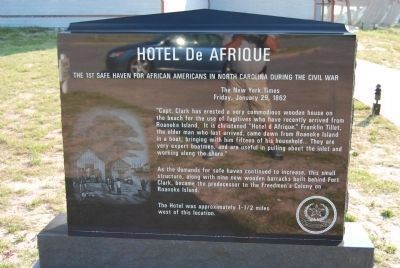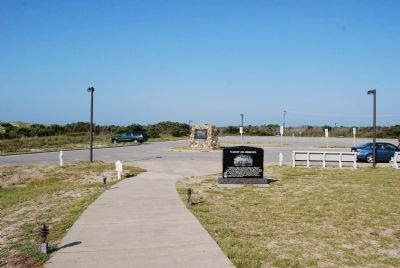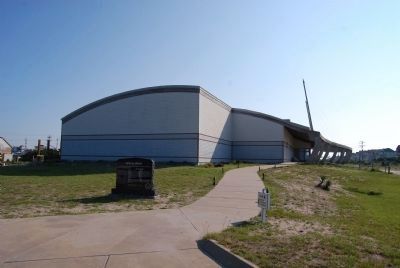Hatteras in Dare County, North Carolina — The American South (South Atlantic)
Flagship USS Minnesota/Hotel de Afrique
Side A:
Side B:
Erected by Dare County Tourism Board.
Topics. This historical marker is listed in these topic lists: African Americans • War, US Civil. A significant historical date for this entry is January 29, 1893.
Location. 35° 12.362′ N, 75° 42.276′ W. Marker is in Hatteras, North Carolina, in Dare County. Marker can be reached from Museum Drive, 0.2 miles west of Coast Guard Drive. Located at sidewalk entrance near parking lot at Graveyard of the Atlantic Museum. Part of the Hatteras Village Guided Tour. Touch for map. Marker is in this post office area: Hatteras NC 27943, United States of America. Touch for directions.
Other nearby markers. At least 8 other markers are within 2 miles of this marker, measured as the crow flies. Maritime Casualties of the American Civil War/Loss of the USS Monitor (a few steps from this marker); Fort Clark / The Bombardment of Fort Hatteras (about 300 feet away, measured in a direct line); Burnside's Expedition Crossing Hatteras Bar/The Burnside Expedition at Hatteras Inlet (about 300 feet away); Propeller From USS Dionysus (about 600 feet away); Welcome to captivating Hatteras Island… (approx. 0.2 miles away); Confederate Forts (approx. 0.2 miles away); America's 1st Attempt at Civil War Reunification (approx. 1.3 miles away); Storm Watch (approx. 1.3 miles away). Touch for a list and map of all markers in Hatteras.
Additional commentary.
1.
On Thursday August 25, 2011 there was a dedication of a Civil War Historic Marker at the Graveyard of the Atlantic Museum in honor of “Hotel De Afrique”, supposedly the first safe haven for runaway slaves in the North Carolina as stated on the memorial.
On closer examination, neither the Carolina Country article or the marker gave a true account of actually events. Even the New York Times of January 29, 1862 reported that the fugitives were “very expert boatmen, and are very useful (to Northern troops) in pulling about the inlet and working along the shore.” The article gave the impression that Northern troops and run away slaves lived in harmony.
However, barely one month later the 48th Pennsylvania Regiment suffered one of its saddest and darkest days in its honored past.
According to regiment reports, on March 11, 1962 Colonel James Nagle sent six companies to reinforce Ambrose Burnside and board the steamer George Peabody. The steamer was aground and the men found themselves inundated with whiskey dealers who were crowding the waterways. Many of the soldiers got drunk and soon fighting broke out among the regiment. However, around midnight, some of the men from Company C broke into the “Hotel De Afrique” and savagely attacked the former slaves. The soldiers attacked the referees with bayonets and Knives cutting several very severely. “Old Gallaway (Colonel Nagle’s) Coulered servant, having bin in for the night, received a Cut in the stomach which will undoubtedly prove fatal. A Contraband had a finger Cut off, the sinew of his left hand Cut” (Captain James Wren’s Civil War Diary, Berkeley Books, 1990).
Gallaway died and the regiment received only a slight reprimand. The murderer or murderers were
never identified.
In conclusion, the article by Michael E.C. Gery, writer and editor for Carolina Country, and the researchers for the NC Historical Marker demonstrates that both took the February 15, 1862 Harper’s Weekly statement that Hotel De Afrique was the “first safe haven” for runaway slaves on face value. Perhaps they were safe from Ole master, but not safe from the drunken murderous Northern Army. Note To Editor only visible by Contributor and editor
— Submitted September 3, 2012, by Edd Charlton of Wadesboro, North Carolina.
Credits. This page was last revised on June 16, 2016. It was originally submitted on August 18, 2011, by Mike Wintermantel of Pittsburgh, Pennsylvania. This page has been viewed 1,158 times since then and 35 times this year. Photos: 1. submitted on August 18, 2011, by Mike Wintermantel of Pittsburgh, Pennsylvania. 2. submitted on August 21, 2011, by Mike Wintermantel of Pittsburgh, Pennsylvania. 3. submitted on August 18, 2011, by Mike Wintermantel of Pittsburgh, Pennsylvania. 4. submitted on August 21, 2011, by Mike Wintermantel of Pittsburgh, Pennsylvania.



